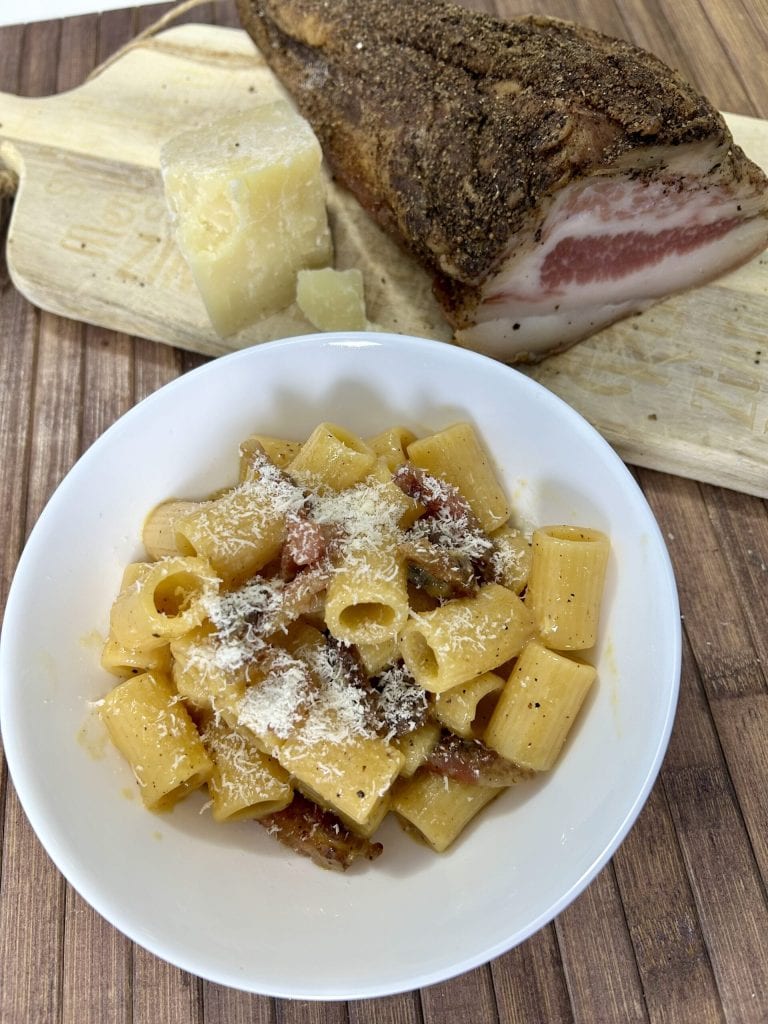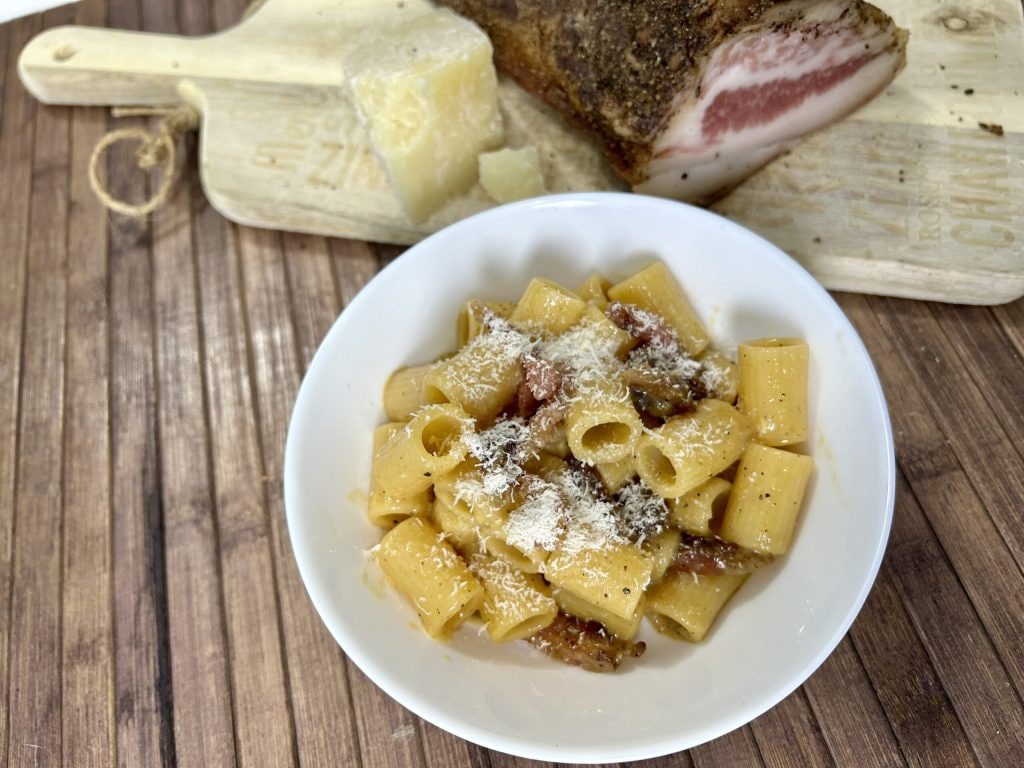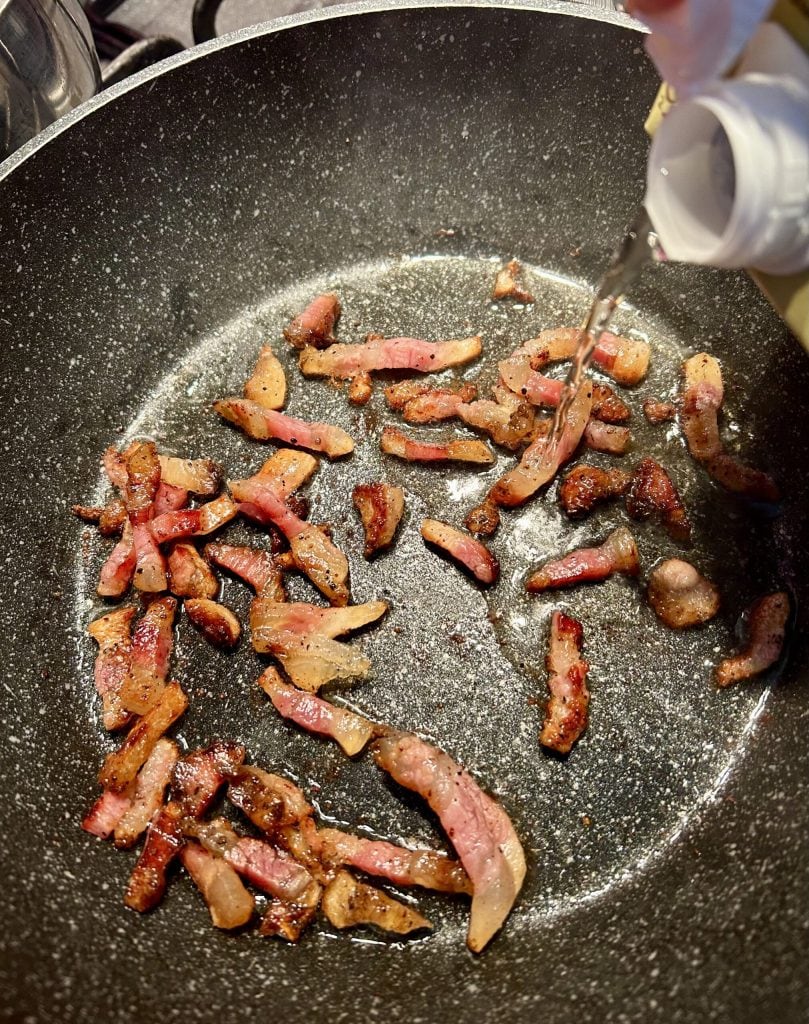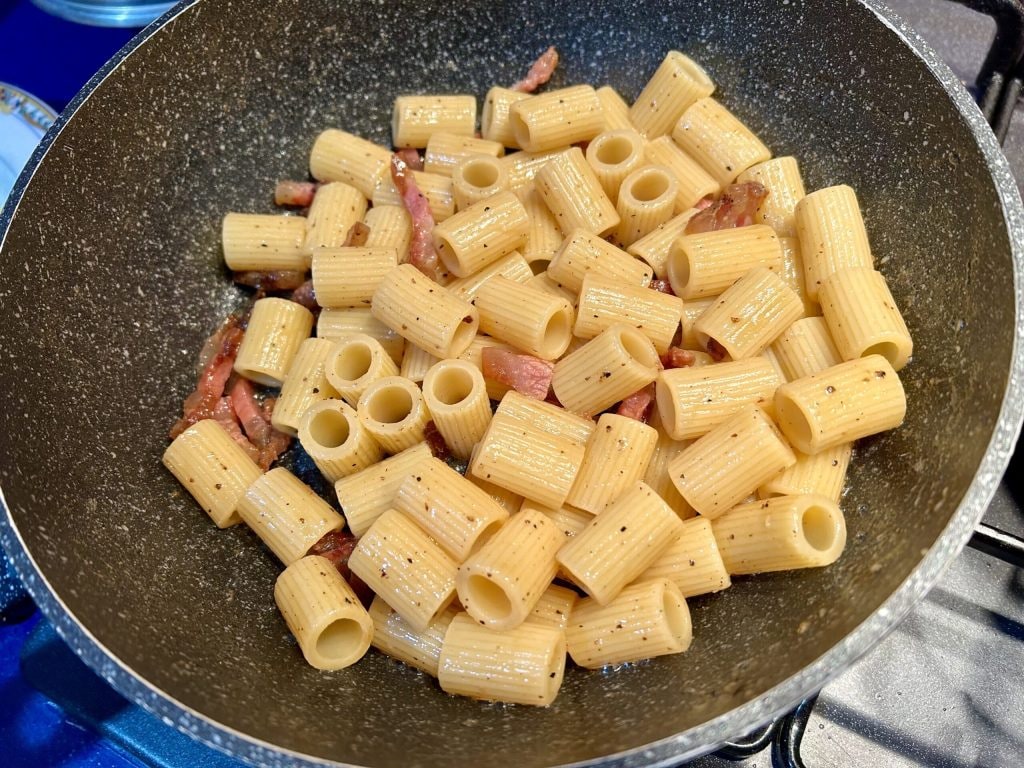Pasta alla Carbonara, a typical dish of Italian cuisine, especially in Lazio and precisely here in Rome, there is no tourist who visits our splendid city without stopping to enjoy a plate of Pasta alla Carbonara.
There are many conflicting stories about the origins of the dish, so I won’t list all the possible theories. Even in the process, there are now many versions, but I propose the classic recipe always used here in Rome.
Pasta alla Carbonara does indeed involve a creamy sauce, but now this search for creaminess, the use of only yolks, and some even adding milk, cream, butter is truly misleading.
Pasta alla Carbonara was born as a simple dish composed only of guanciale, Pecorino Romano, deglazed with white wine, and black pepper. Those who don’t like using wine can use pasta cooking water as an alternative.
The type of pasta typically used for this dish are rigatoni or mezze maniche. Spaghetti are often used to present this dish, especially by modern chefs who emphasize the creaminess of the sauce. In reality, the sauce remains creamy because the eggs are added off the heat and therefore do not set like an omelet. The main ingredient of this dish cannot be anything other than excellent guanciale, crispy on the outside and soft on the inside.
This habit of browning the guanciale to set it aside and add it only as a garnish is absolutely not part of the original recipe. The guanciale should be well-browned and used to toss the pasta before adding the egg, which is why rigatoni and mezze maniche are the most suitable formats to embrace it well.
For lovers of simple traditional dishes, I also recall

- Difficulty: Easy
- Cost: Economical
- Preparation time: 15 Minutes
- Portions: 2
- Cooking methods: Stovetop
- Cuisine: Italian
- Energy 841.74 (Kcal)
- Carbohydrates 58.80 (g) of which sugars 1.77 (g)
- Proteins 24.89 (g)
- Fat 55.46 (g) of which saturated 21.93 (g)of which unsaturated 27.99 (g)
- Fibers 1.61 (g)
- Sodium 2,785.35 (mg)
Indicative values for a portion of 210 g processed in an automated way starting from the nutritional information available on the CREA* and FoodData Central** databases. It is not food and / or nutritional advice.
* CREATES Food and Nutrition Research Center: https://www.crea.gov.it/alimenti-e-nutrizione https://www.alimentinutrizione.it ** U.S. Department of Agriculture, Agricultural Research Service. FoodData Central, 2019. https://fdc.nal.usda.gov
Ingredients
In Pasta alla Carbonara, you must use guanciale, and it cannot be replaced with pancetta due to the difference in fat content, which helps to brown it without adding oil and keeping it soft in addition to being crispy.
- 2 slices guanciale
- 1 egg
- 1 yolk
- 50 g Pecorino Romano (grated)
- to taste salt
- to taste black pepper
- 1/4 glass white wine
- 160 g mezze maniche rigate
- 1 l water (to boil the pasta)
- 4 g coarse salt (to salt the water)
Tools
To properly cut the guanciale, I suggest a good chef’s knife with a smooth blade and a cutting board. For cooking, a good deep-sided non-stick pan to toss the pasta and to cook the guanciale without adding oil.
- 1 Knife
- 1 Cutting Board
- 1 Pan
Preparation
The first step to preparing a good plate of pasta alla carbonara is to bring the water for cooking the pasta to a boil with the coarse salt. When it boils, throw in the pasta and cook it for the minutes indicated on the package to have al dente pasta. During these approximately 20 minutes, you should prepare the sauce.

Cut the guanciale into strips using the smooth-bladed knife and brown it in the pan without adding other fats. To brown it well, use the lid, and the flame should be lively but not too high. Stir it occasionally so that it is crispy all over but remains soft inside. When it is well browned, raise the flame and deglaze with white wine, let it reduce for about a minute, and turn off the heat.

In a bowl, place the whole egg and the yolk, add salt with caution as the recipe requires Pecorino Romano, which is very flavorful. Add the pepper and half of the Pecorino required by the recipe. Beat well with a fork to make everything homogeneous; you should obtain a homogeneous egg cream.

When the pasta is cooked, drain it not too dry and pour it into the pan with the guanciale and mix it well. To be safe, keep some cooking water aside, but you shouldn’t need it. If the guanciale has cooled too much, you can turn on the flame to bring it to temperature but turn it off when you add the pasta. After mixing the pasta with the guanciale, add the egg cream and make everything homogeneous. This operation must be done off the heat because the egg should not set like an omelet but remain soft. Serve your Pasta alla Carbonara by adding a nice sprinkle of Pecorino on each plate.

NOTE
Pasta alla Carbonara should be consumed immediately after preparation, but if done well, it will be difficult to have leftovers! For those who really don’t love the taste of Pecorino, you can substitute it with Parmesan; the taste will be a bit less intense but still very tasty.
If you enjoyed the recipe or have questions, feel free to comment here or on social media Facebook, Pinterest, Instagram and X.

